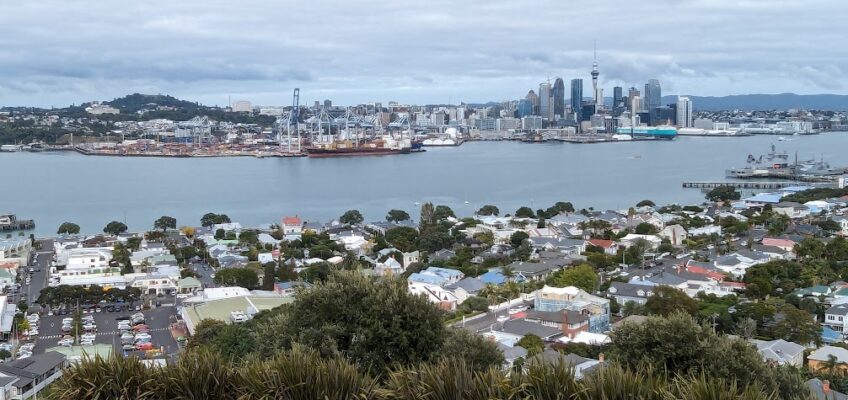After four days in Fiji and six days in Australia, I arrived in Auckland late last Wednesday night to start my OAT tour of New Zealand.
Here’s where I write about what I’ve done the last three days. If you want to skip to the photos, here they are. But if you want to read, I promise I’m not going to bore you with every detail. (I know I have a tendency to do that.) Here are just the high points.
Arriving at Auckland Airport
Going through immigration and customs at AKL was easy peasy. They warn you ahead of time about introducing anything that could pose a bio hazard in New Zealand, and on the form I checked the box for shoes because I walked in other countries with my shoes. But the customs official just asked if my shoes were clean, and I said yes.
Getting to the shuttle was not so easy. I felt like I needed to walk a mile. The signage was good, and it looked like they are in the process of making some improvements, but in the meantime, the shuttle location was very far from the terminal.
At any rate, by the time I made it to my hotel, the voco Auckland City Centre, it was almost 12:30 am. A long day after starting out from Cairns at 9am.
Devonport
On Thursday the OAT experience began with our orientation meeting at 3:30. So I decided to visit Devonport in the morning. This was one of the suggestions OAT made for free time in Auckland.
At breakfast I met a couple of the other tour participants, and Harold and Pat, a couple from New Mexico, decided to join me on the outing. We walked to the ferry and rode across the harbour to the pretty neighborhood of Devonport. We did a little walking around, including climbing Mount Victoria (really just a hill) and exploring some of the shops. And we had lunch before heading back.
Bastion Point
On Wednesday afternoon after our orientation meeting we had a short stroll around the the city centre, and on Thursday morning we had a slightly longer walking tour before heading by bus to Bastion Point, or in Maori, Takaparawhau. Here we met Ra, a member of the Maori community who welcomed us in a traditional manner and showed us around the area, telling us about the importance of this land to the Maori and sharing some history.
Ra told us this story, and she expressed concern about the new right-wing government that won last year’s elections. There are fears that recognition of Maori rights and culture will be rolled back under this government.
It’s sad and disappointing to me to learn about the mistreatment of indigenous people in New Zealand, as in Australia, as in the country of my birth. There have been acknowledgement of past injustices, and attempts at reconciliation and reparation, but it feels like social justice with respect to native peoples is tenuous everywhere.
Auckland Art Gallery
The Auckland Art Gallery, the city’s primary museum of art, has a small but surprisingly strong collection. I visited there in the afternoon yesterday.
The highlight of the is a gift from an American who died last year and left his collection of fifteen works by influential modern European artists to the Gallery. But I also enjoyed the exhibit entitled “Threads of Time: Travel, Trade, and Textiles.”
Cow in Meadow, Rouen 1884
La Tasse [The Cup] 1912
Mère aux enfants à l’orange 1951
Waiheke Island
Today we took the ferry to Waiheke Island, where we visited a winery for lunch and a wine tasting. We also visited an olive oil farm (orchard?) and did a tasting there. This island has a microclimate that makes it ideal for growing Mediterranean products like grapes and olives.
The island itself was very picturesque, and the lunch was good. I didn’t love the wine or the olive oil.
Final thoughts about Auckland
This is a nice city, but not a favorite by any means. There is some interesting architecture, and certainly the setting on the water is a plus. But I don’t think it’s a particularly special travel destination, and I’m definitely ready and eager to see more of New Zealand.
I’m enjoying getting to know my fellow travelers, and Mark, our Trip Experience Leader with OAT, is fabulous! I know he will make this country come alive as we head out to other parts.
Oh, and I’ve had some great Asian food. It’s made me realize how much I miss really good Asian food living in Mexico.
Tomorrow we depart for Rotorua. See you there!


Timothy Welch
Lane, as usual, thanks for the great photos and honest stories. I feel like I’m right there with you, especially the olive grove and winery!
Lane
Tim, coming from someone who writes about his own travels so beautifully, this means a lot. Thank you!
Tammy
Well, I’ve been to Auckland and Waiheke Island. Agree with all your points, except I didn’t try the olive oil. I loved Rotorua! The luge was fun!